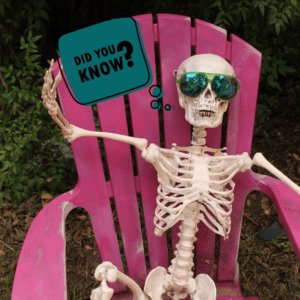Have you heard of endometriosis? 🤔
It is a condition that affects many women 🙋🏻♀️, but it’s also one that hasn’t been spoken about very much in the past.
Today we want to tell you more about this condition which can affect an estimated 1 in 10 women of reproductive age in the UK. Approximately 176 million women worldwide are thought to have this condition as well, which is why it is time it was better understood.
Support for yourself or the women in your life is important for managing this condition. Read more:
Endometriosis is an often very painful condition in which tissue that is similar to the lining of the uterus (the endometrium) starts to grow in other places!
What is endometriosis?
Endometriosis (pronounced en-doe-me-tree-O-sis) is an often very painful condition in which tissue that is similar to the lining of the uterus (the endometrium) starts to grow in other places – like the ovaries, or fallopian tubes – outside your uterus.
With endometriosis, the tissue acts as it would inside the womb – it thickens, breaks down and bleeds with each menstrual cycle 🩸. But because this tissue is not inside the uterus, but rather in other parts of the body, it has no way to exit, becoming trapped.
When endometriosis involves the ovaries, cysts can form. Surrounding tissue can become irritated and eventually develop scar tissue and adhesions, which are abnormal bands of fibrous tissue that cause organs and pelvic tissues to stick to each other. This condition causes pain particularly during menstrual periods and can affect fertility.
How does endometriosis develop?
Not much is known about the exact cause of endometriosis, but there are several possible explanations 💁♀️. These include:
· Retrograde menstruation. This is when menstrual blood containing endometrial cells flows back through the fallopian tubes and into the pelvic cavity instead of out of the body as they normally would.
· Transformation of peritoneal cells. This is what is known as the “induction theory,” which suggests that hormones or immune factors promote the transformation of cells that line the inner side of your abdomen (peritoneal cells) into endometrial-like cells.
· Embryonic cell transformation. Hormones such as oestrogen may transform embryonic cells — namely, those cells in the earliest stages of development — into endometrial-like cell implants during puberty.
· Surgical scar implantation. After a surgery, such as a hysterectomy or a C-section, endometrial cells may attach to a surgical incision.
· Endometrial cell transport. The blood vessels or tissue fluid (lymphatic) system may transport endometrial cells to other parts of the body.
· Immune system disorder. A problem with the immune system may make the body unable to recognise and destroy endometrial-like tissue that’s growing outside the uterus.
It’s important to note that early detection is really important in good management of this condition. So, see your GP as soon as you can if you are concerned that you may be experiencing symptoms.
Who can develop endometriosis?
Women of any age can suffer through the symptoms of this condition, and it is a long-term condition that can often have significant impacts on your daily life.
There are several risk factors that are thought to exacerbate the risk of developing endometriosis. They are:
– Having never given birth
– Starting your period at a very early age
– Going through a late menopause
– Having very short menstrual cycles – namely, less than 27 days in total
– Having very heavy menstrual periods that last over 7 days
– Having a higher level of oestrogen in your body
– A low body mass index
– Having one or more relatives with endometriosis
– Any other medical condition that prevents the normal passage of menstrual flow from the body
– Any reproductive tract abnormalities in the body
Endometriosis is sometimes mistaken for other conditions that can cause pelvic pain, like pelvic inflammatory disease (PID) or ovarian cysts. It can also be confused with irritable bowel syndrome (IBS), which causes bouts of diarrhoea, constipation and abdominal cramping. IBS can also accompany endometriosis, which can complicate the diagnosis.
What are the symptoms of endometriosis?
Symptoms of this condition can really vary. Common signs and symptoms of endometriosis include:
· Painful periods 🤕. Pelvic pain and cramping can begin before and extend several days into a menstrual period. You may also experience lower back and abdominal pain.
· Pain during intercourse. Pain during or after sex is common with endometriosis.
· Pain with bowel movements or urination. You’re most likely to experience these symptoms during a menstrual period.
· Excessive bleeding. You may experience very heavy menstrual periods or bleeding between periods (known as intermenstrual bleeding).
· Infertility. Sometimes, endometriosis is first diagnosed in those seeking treatment for infertility.
· Other signs and symptoms include fatigue 😴, diarrhoea, constipation, bloating or nausea 🤢, especially during menstrual periods.
It should be noted that the severity of your pain isn’t always a good indicator of the extent of the condition – you can have very mild endometriosis and severe pain, or you can have very advanced endometriosis with little or no pain at all.
What can you do to alleviate the symptoms?
Treatment plans vary from individual to individual. Your doctor 👩⚕️ will recommend various kinds of pain medication, as well as hormone therapy or even surgery, depending on the extent of the condition. As endometriosis can impact fertility, specific treatments for fertility may also be recommended if you are trying to become pregnant.
You may wish to support any and all of these options with good lifestyle choices and home treatment help, including:
Diet and Supplements 🥗
Though there isn’t any clear advice on the best diet for someone with this condition, but healthy eating can improve overall health which may improve symptoms. Make sure you’re having a diet high in fibre and plant-based foods, and plenty of omega-3 rich foods or supplements.
Some endometriosis medications lower oestrogen in the body, and if you are on this type of medication, this can also lower the amount of calcium and Vitamin D being absorbed. Speak to your GP about taking a supplement for these can help protect the health of your bones.
Exercise 🏃♂️
Exercise helps to release endorphins, a natural kind of pain relief in the body. It can also help improve your circulation, which is important for carrying oxygen and nutrients to all body systems.
Learn more about endometriosis and the support that is available out there on Endometriosis UK. In addition to detailed information about endometriosis, Endometriosis UK has a directory of local support groups, a helpline on 0808 808 2227, and an online community for women affected by the condition.





